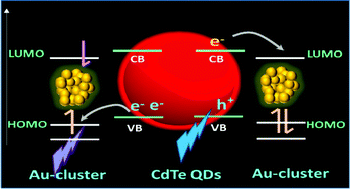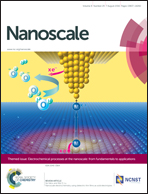Photoinduced 2-way electron transfer in composites of metal nanoclusters and semiconductor quantum dots†
Abstract
In order to explore the potential of nanocomposites comprising semiconductor quantum dots (QDs) and metal nanoclusters (NCs) in photovoltaic and catalytic applications, the interaction between CdTe QDs and gold NCs, Au10 and Au25, stabilized by histidine, bovine serum albumin (BSA) and glutathione, is studied by an ultrafast transient absorption (TA) technique. Temporal and spectral studies of the transients reveal photoinduced 2-way electron transfer between the two constituents of the nanocomposites, where Au NCs, which generally act as electron donors when used as photosensitizers, perform the role of the efficient electron acceptor. Interestingly, it is found that the electron transfer dynamics in these composites is governed not by the distance of separation of the constituents but by the nature of the surface capping ligands. Despite a large separation between the QDs and NCs in a giant BSA-capped system, a higher electron transfer rate in this composite suggests that unlike other smaller capping agents, which act more like insulators, BSA allows much better electron conduction, as indicated previously.


 Please wait while we load your content...
Please wait while we load your content...